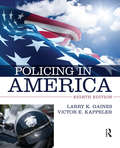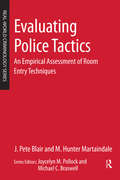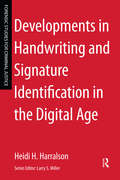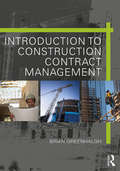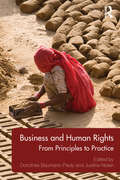- Table View
- List View
Policing in America
by Larry K. Gaines Victor E. KappelerIn the field of law enforcement in the United States, it is essential to know the contemporary problems being faced and combine that knowledge with empirical research and theoretical reasoning to arrive at best practices and an understanding of policing. Policing in America, Eighth Edition, provides a thorough analysis of the key issues in policing today, and offers an issues-oriented discussion focusing on critical concerns such as personnel systems, organization and management, operations, discretion, use of force, culture and behavior, ethics and deviance, civil liability, and police-community relations. A critical assessment of police history and the role politics played in the development of American police institutions is also addressed, as well as globalization, terrorism, and homeland security. This new edition not only offers updated research and examples, it also incorporates more ways for the reader to connect to the content through learning objectives, discussion questions, and "Myths and Realities of Policing" boxes. Video and Internet links provide additional coverage of important issues. With completely revised and updated chapters, Policing in America, Eighth Edition provides an up-to-date examination of what to expect as a police officer in America.
Implementing a Gender-Based Arts Program for Juvenile Offenders
by Jill Leslie Rosenbaum Shelley SpivackStudies have shown that arts-based programming in juvenile detention settings can be an effective tool in rehabilitating and reintegrating youth who have come into contact with the juvenile justice system. Implementing a Gender-Based Arts Program for Juvenile Offenders focuses on a 2012-2013 program in Flint, Michigan and demonstrates that visual arts and poetry can be used effectively with young people in detention centers to improve self-image, increase confidence, and improve writing skills. Describing the program in detail, including the subjects addressed, the unforeseen pitfalls, and how individual lessons evolved over time, Implementing a Gender-Based Arts Program for Juvenile Offenders combines practical advice with a discussion of current literature on the use of integrating arts in juvenile correctional settings, as well as the literature identifying the need for gender-based programs, to provide guidance to juvenile justice and corrections professionals in their efforts to rehabilitate young people. About the Real-World Criminology Series More than just textbooks, the short books in the Real-World Criminology series are designed to be of interest to particular fields within criminology. They can be policy primers, spurring innovations in policing and corrections, theoretical works dealing with policy implications, or program evaluations incorporating theoretical foundations. Each book covers something that is happening –or should be happening—in the world of criminal justice.
Implementing a Gender-Based Arts Program for Juvenile Offenders
by Jill Leslie Rosenbaum Shelley SpivackStudies have shown that arts-based programming in juvenile detention settings can be an effective tool in rehabilitating and reintegrating youth who have come into contact with the juvenile justice system. Implementing a Gender-Based Arts Program for Juvenile Offenders focuses on a 2012-2013 program in Flint, Michigan and demonstrates that visual arts and poetry can be used effectively with young people in detention centers to improve self-image, increase confidence, and improve writing skills. Describing the program in detail, including the subjects addressed, the unforeseen pitfalls, and how individual lessons evolved over time, Implementing a Gender-Based Arts Program for Juvenile Offenders combines practical advice with a discussion of current literature on the use of integrating arts in juvenile correctional settings, as well as the literature identifying the need for gender-based programs, to provide guidance to juvenile justice and corrections professionals in their efforts to rehabilitate young people. About the Real-World Criminology Series More than just textbooks, the short books in the Real-World Criminology series are designed to be of interest to particular fields within criminology. They can be policy primers, spurring innovations in policing and corrections, theoretical works dealing with policy implications, or program evaluations incorporating theoretical foundations. Each book covers something that is happening –or should be happening—in the world of criminal justice.
Forensic Investigation of Sex Crimes and Sexual Offenders
by Chris Rush Burkey Tusty Ten Bensel Jeffery T. WalkerThe investigation of sex crimes is a specific function for many law enforcement agencies, requiring an understanding of how to investigate, process crime scenes, interact with victims and offenders, and prepare for court. Drawing on new methods of investigation and the effects of such crimes on victims, Forensic Investigation of Sex Crimes and Sexual Offenders provides in-depth coverage in these areas, offering a valuable supplement for criminal justice courses and an accessible guide for law enforcement.
Forensic Investigation of Sex Crimes and Sexual Offenders
by Chris Rush Burkey Tusty Ten Bensel Jeffery T. WalkerThe investigation of sex crimes is a specific function for many law enforcement agencies, requiring an understanding of how to investigate, process crime scenes, interact with victims and offenders, and prepare for court. Drawing on new methods of investigation and the effects of such crimes on victims, Forensic Investigation of Sex Crimes and Sexual Offenders provides in-depth coverage in these areas, offering a valuable supplement for criminal justice courses and an accessible guide for law enforcement.
Evaluating Police Tactics: An Empirical Assessment of Room Entry Techniques
by J. Pete Blair M. Hunter MartaindaleThe approach that should be used by law enforcement officers in order to safely and effectively enter a room is a point of contention among many police trainers. Based on five experiments conducted over a two-year period, Evaluating Police Tactics demonstrates that the conventional wisdom is not optimal. Using the scientific method to systematically assess current room entry philosophies and techniques employed by police, Evaluating Police Tactics offers suggestions for examining the current philosophies and determining how patrol officers can enter scenes of ongoing violence, find the shooter, and stop the killing as safely and effectively as possible. About the Real-World Criminology Series More than just textbooks, the short books in the Real-World Criminology series are designed to be of interest to particular fields within criminology. They can be policy primers, spurring innovations in policing and corrections, theoretical works dealing with policy implications, or program evaluations incorporating theoretical foundations. Each book covers something that is happening –or should be happening—in the world of criminal justice.
Evaluating Police Tactics: An Empirical Assessment of Room Entry Techniques
by J. Pete Blair M. Hunter MartaindaleThe approach that should be used by law enforcement officers in order to safely and effectively enter a room is a point of contention among many police trainers. Based on five experiments conducted over a two-year period, Evaluating Police Tactics demonstrates that the conventional wisdom is not optimal. Using the scientific method to systematically assess current room entry philosophies and techniques employed by police, Evaluating Police Tactics offers suggestions for examining the current philosophies and determining how patrol officers can enter scenes of ongoing violence, find the shooter, and stop the killing as safely and effectively as possible. About the Real-World Criminology Series More than just textbooks, the short books in the Real-World Criminology series are designed to be of interest to particular fields within criminology. They can be policy primers, spurring innovations in policing and corrections, theoretical works dealing with policy implications, or program evaluations incorporating theoretical foundations. Each book covers something that is happening –or should be happening—in the world of criminal justice.
Developments in Handwriting and Signature Identification in the Digital Age
by Heidi H. HarralsonThe examination of handwriting and signatures has a long and established history as a forensic discipline. With the advancement of technology in the use of digital tablets for signature capture, changes in handwriting examination are necessary. Other changes in handwriting, such as in increase in printed writing styles and the decrease in handwriting training in schools necessitates a re-examination of forensic handwriting identification problems. This text takes a fresh and modern look at handwriting examination as it pertains to forensic, legal, and criminal justice applications.
Developments in Handwriting and Signature Identification in the Digital Age
by Heidi H. HarralsonThe examination of handwriting and signatures has a long and established history as a forensic discipline. With the advancement of technology in the use of digital tablets for signature capture, changes in handwriting examination are necessary. Other changes in handwriting, such as in increase in printed writing styles and the decrease in handwriting training in schools necessitates a re-examination of forensic handwriting identification problems. This text takes a fresh and modern look at handwriting examination as it pertains to forensic, legal, and criminal justice applications.
Criminal Investigation: A Method for Reconstructing the Past
by James W. Osterburg Richard H. WardThis text presents the fundamentals of criminal investigation and provides a sound method for reconstructing a past event (i.e., a crime), based on three major sources of information — people, records, and physical evidence. Its tried-and-true system for conducting an investigation is updated with the latest techniques available, teaching the reader new ways of obtaining information from people, including mining the social media outlets now used by a broad spectrum of the public; how to navigate the labyrinth of records and files currently available online; and fresh ways of gathering, identifying, and analyzing physical evidence.
Criminal Investigation: A Method for Reconstructing the Past
by James W. Osterburg Richard H. WardThis text presents the fundamentals of criminal investigation and provides a sound method for reconstructing a past event (i.e., a crime), based on three major sources of information — people, records, and physical evidence. Its tried-and-true system for conducting an investigation is updated with the latest techniques available, teaching the reader new ways of obtaining information from people, including mining the social media outlets now used by a broad spectrum of the public; how to navigate the labyrinth of records and files currently available online; and fresh ways of gathering, identifying, and analyzing physical evidence.
Criminal Evidence
by Jefferson L. IngramIn addition to covering the basics of collecting, preserving and presenting evidence, Criminal Evidence, 12th edition, presents the latest developments in the law of evidence that are of interest to criminal justice personnel. Highlights include: chapter outlines, lists of key terms and concepts for each chapter, a glossary, and new, up-to-date cases in Part II. Thoroughly revised, updated, and streamlined to include recent case law on evidence Each chapter includes outlines, key terms and concepts, and review questions to aid understanding Appendices include a helpful glossary; Federal Rules of Evidence as amended and effective through December 1, 2013; Table of Jurisdictions That Have Adopted Some System of Uniform Rules for Regulating the Admission and Exclusion of Evidence through 2014; and Table of Contents of the Uniform Rules of Evidence with 2005 Amendments
Criminal Evidence
by Jefferson L. IngramIn addition to covering the basics of collecting, preserving and presenting evidence, Criminal Evidence, 12th edition, presents the latest developments in the law of evidence that are of interest to criminal justice personnel. Highlights include: chapter outlines, lists of key terms and concepts for each chapter, a glossary, and new, up-to-date cases in Part II. Thoroughly revised, updated, and streamlined to include recent case law on evidence Each chapter includes outlines, key terms and concepts, and review questions to aid understanding Appendices include a helpful glossary; Federal Rules of Evidence as amended and effective through December 1, 2013; Table of Jurisdictions That Have Adopted Some System of Uniform Rules for Regulating the Admission and Exclusion of Evidence through 2014; and Table of Contents of the Uniform Rules of Evidence with 2005 Amendments
Alternate Light Source Imaging: Forensic Photography Techniques
by Norman Marin Jeffrey BuszkaAlternate Light Source Imaging provides a brief guide to digital imaging using reflected infrared and ultraviolet radiation for crime scene photographers. Clear and concise instruction illustrates how to accomplish good photographs in a variety of forensic situations. It demonstrates how tunable wavelength light sources and digital imaging techniques can be used to successfully locate and document physical evidence at the crime scene, in the morgue, or in the laboratory. The scientific principles that make this type of photography possible are described, followed by the basic steps that can be utilized to capture high quality evidentiary photographs.
Alternate Light Source Imaging: Forensic Photography Techniques
by Norman Marin Jeffrey BuszkaAlternate Light Source Imaging provides a brief guide to digital imaging using reflected infrared and ultraviolet radiation for crime scene photographers. Clear and concise instruction illustrates how to accomplish good photographs in a variety of forensic situations. It demonstrates how tunable wavelength light sources and digital imaging techniques can be used to successfully locate and document physical evidence at the crime scene, in the morgue, or in the laboratory. The scientific principles that make this type of photography possible are described, followed by the basic steps that can be utilized to capture high quality evidentiary photographs.
International Business Law and the Legal Environment: A Transactional Approach
by Larry A. DiMatteoInternational Business Law and the Legal Environment provides business students with a strong understanding of the legal principles that govern doing business internationally. Not merely about compliance, this book emphasizes how to use the law to create value and competitive advantage. DiMatteo’s transactional approach walks students through key business transactions—from import and export, contracts, and finance to countertrade, dispute resolution, licensing, and more—giving them both context and demonstrating real world application. This new edition also includes: New material on comparative contract and sales law & European private law; joint ventures and collaborative alliances. A new part on foreign direct investment that includes a chapter on emerging markets. New chapters on privacy law, and on environmental concerns. Greater coverage of the World Trade Organization. "Case highlights" and court opinions that feature edited court transcripts which expose students to actual legal reasoning and an understanding of the underlying legal principles. These decisions are drawn from a broad range of countries, offering a truly international look at the subject. Students of business law and international business courses will find DiMatteo’s clear writing style easy to follow. A companion web site includes an instructor’s manual, PowerPoints, and other tools to provide additional support for students and instructors.
International Business Law and the Legal Environment: A Transactional Approach
by Larry A. DiMatteoInternational Business Law and the Legal Environment provides business students with a strong understanding of the legal principles that govern doing business internationally. Not merely about compliance, this book emphasizes how to use the law to create value and competitive advantage. DiMatteo’s transactional approach walks students through key business transactions—from import and export, contracts, and finance to countertrade, dispute resolution, licensing, and more—giving them both context and demonstrating real world application. This new edition also includes: New material on comparative contract and sales law & European private law; joint ventures and collaborative alliances. A new part on foreign direct investment that includes a chapter on emerging markets. New chapters on privacy law, and on environmental concerns. Greater coverage of the World Trade Organization. "Case highlights" and court opinions that feature edited court transcripts which expose students to actual legal reasoning and an understanding of the underlying legal principles. These decisions are drawn from a broad range of countries, offering a truly international look at the subject. Students of business law and international business courses will find DiMatteo’s clear writing style easy to follow. A companion web site includes an instructor’s manual, PowerPoints, and other tools to provide additional support for students and instructors.
Introduction to Construction Contract Management
by Brian GreenhalghThis book is an introduction to construction contract administration and management, covering the delivery and execution stage of a construction project and the various issues which the contract administrator needs to proactively manage. It can therefore be used as a contract administrator’s resource book covering what needs to be done (and why) to keep a construction project on track from a commercial and contractual perspective. It is particularly appropriate for students and new practitioners from varied construction professions and whilst it covers domestic (UK) projects, it will be particularly useful for those studying and working on international projects where terminology, procedures and legal systems may differ from the UK. The content is split into four parts and is subdivided into easy-to-read chapters replicating the timeline of a project during the construction stage: Part A covers initiating the construction stage, project delivery mechanisms, contract administration and health and safety management; Part B covers managing the construction stage, contractor performance and relationship management; Part C covers finalising the construction stage, project completion and close-out; Part D covers claims and disputes. Introduction to Construction Contract Management will be particularly useful for students enrolled on global construction programmes together with international distance learning students and non-cognate graduates starting out on an international career in construction contract administration and quantity surveying.
Agricultural and Agribusiness Law: An introduction for non-lawyers
by Theodore A. FeitshansThis introductory textbook provides an overview of the concepts necessary for an understanding of agricultural and agribusiness law. The text will help students of land-based industries with little or no legal background to appreciate and identify issues which may require referral or consultation with legal counsel. Each concise chapter addresses a different legal issue that those employed in agriculture and agribusiness may face, and both federal law and representative examples of state law are included. In addition to traditional topics such as contracts, property law and estate planning, the book also covers more contemporary issues such as organic certification, animal law, genetically engineered crops and food safety. Agricultural law extends beyond those directly engaged in farming to those in agribusiness who provide services and inputs to farmers, buy farmers’ products, store or transport products, manufacture food products, and serve as intermediaries between farmers and consumers. The book will therefore also serve as a reference and a guide for those employed in agribusiness as well as agriculture.
Agricultural and Agribusiness Law: An introduction for non-lawyers
by Theodore A. FeitshansThis introductory textbook provides an overview of the concepts necessary for an understanding of agricultural and agribusiness law. The text will help students of land-based industries with little or no legal background to appreciate and identify issues which may require referral or consultation with legal counsel. Each concise chapter addresses a different legal issue that those employed in agriculture and agribusiness may face, and both federal law and representative examples of state law are included. In addition to traditional topics such as contracts, property law and estate planning, the book also covers more contemporary issues such as organic certification, animal law, genetically engineered crops and food safety. Agricultural law extends beyond those directly engaged in farming to those in agribusiness who provide services and inputs to farmers, buy farmers’ products, store or transport products, manufacture food products, and serve as intermediaries between farmers and consumers. The book will therefore also serve as a reference and a guide for those employed in agribusiness as well as agriculture.
Business and Human Rights: From Principles to Practice
by Dorothée Baumann-Pauly Justine NolanIn a global economy, multinational companies often operate in jurisdictions where governments are either unable or unwilling to uphold even the basic human rights of their citizens. The expectation that companies respect human rights in their own operations and in their business relationships is now a business reality that corporations need to respond to. Business and Human Rights: From Principles to Practice is the first comprehensive and interdisciplinary textbook that addresses these issues. It examines the regulatory framework that grounds the business and human rights debate and highlights the business and legal challenges faced by companies and stakeholders in improving respect for human rights, exploring such topics as: the regulatory framework that grounds the business and human rights debate challenges faced by companies and stakeholders in improving human rights industry-specific human rights standards current mechanisms to hold corporations to account future challenges for business and human rights With supporting case studies throughout, this text provides an overview of current themes in the field and guidance on practical implementation, demonstrating that a thorough understanding of the human rights challenges faced by business is now vital in any business context.
Equity and Trusts
by Scott AtkinsEquity and Trusts is an ideal choice for all undergraduate and GDL students looking for a comprehensive yet accessible textbook on this complex area of law. The author’s clear writing style, plentiful explanations and focus on modern case law demystify difficult concepts and help to bring the subject to life. Equity and Trusts is shown to be a live, growing and developing subject, with an important historical underpinning that ensures students gain a sound grasp of key material and understand both its history and current application. Clearly written and easy to use, Equity and Trusts enables students to fully engage with the topic and gain a profound understanding of this fundamental area. The Routledge Spotlights series brings a modern, contemporary approach to the core curriculum for the LLB and GDL which will help students Move beyond an understanding of the law Refine and develop the key skills of problem-solving, evaluation and critical reasoning which are essential to exam success Discover sources and suggestions for taking your study further By focusing on recent case law and real-world examples, Routledge Spotlights will help you shed light on the law, understand how it operates in practice and gain a unique appreciation of the contemporary context of the subject. Companion Website www.routledge.com/cw/spotlights This book is supported by a range of online resources developed to support your learning, keep you up-to-date and to help you prepare for assessments.
Equity and Trusts
by Scott AtkinsEquity and Trusts is an ideal choice for all undergraduate and GDL students looking for a comprehensive yet accessible textbook on this complex area of law. The author’s clear writing style, plentiful explanations and focus on modern case law demystify difficult concepts and help to bring the subject to life. Equity and Trusts is shown to be a live, growing and developing subject, with an important historical underpinning that ensures students gain a sound grasp of key material and understand both its history and current application. Clearly written and easy to use, Equity and Trusts enables students to fully engage with the topic and gain a profound understanding of this fundamental area. The Routledge Spotlights series brings a modern, contemporary approach to the core curriculum for the LLB and GDL which will help students Move beyond an understanding of the law Refine and develop the key skills of problem-solving, evaluation and critical reasoning which are essential to exam success Discover sources and suggestions for taking your study further By focusing on recent case law and real-world examples, Routledge Spotlights will help you shed light on the law, understand how it operates in practice and gain a unique appreciation of the contemporary context of the subject. Companion Website www.routledge.com/cw/spotlights This book is supported by a range of online resources developed to support your learning, keep you up-to-date and to help you prepare for assessments.
Unlocking Evidence
by Charanjit Singh Mohamed RamjohnUnlocking Evidence will help you grasp the main concepts of the subject with ease. Containing accessible explanations in clear and precise terms that are easy to understand, it provides an excellent foundation for learning and revising Evidence. The information is clearly presented in a logical structure and the following features support learning helping you to advance with confidence: Clear learning outcomes at the beginning of each chapter set out the skills and knowledge you will need to get to grips with the subject Key Facts summaries throughout each chapter allow you to progressively build and consolidate your understanding End-of-chapter summaries provide a useful check-list for each topic Cases and judgments are highlighted to help you find them and add them to your notes quickly Frequent activities and self-test questions are included so you can put your knowledge into practice Sample essay questions with annotated answers prepare you for assessment Glossary of legal terms clarifies important definitions This edition has been updated to include the most recent updates in case law and criminal and civil procedure, including developments relating to vulnerable witnesses and character evidence as well as interventions by the trial judge.
Unlocking Evidence
by Charanjit Singh Mohamed RamjohnUnlocking Evidence will help you grasp the main concepts of the subject with ease. Containing accessible explanations in clear and precise terms that are easy to understand, it provides an excellent foundation for learning and revising Evidence. The information is clearly presented in a logical structure and the following features support learning helping you to advance with confidence: Clear learning outcomes at the beginning of each chapter set out the skills and knowledge you will need to get to grips with the subject Key Facts summaries throughout each chapter allow you to progressively build and consolidate your understanding End-of-chapter summaries provide a useful check-list for each topic Cases and judgments are highlighted to help you find them and add them to your notes quickly Frequent activities and self-test questions are included so you can put your knowledge into practice Sample essay questions with annotated answers prepare you for assessment Glossary of legal terms clarifies important definitions This edition has been updated to include the most recent updates in case law and criminal and civil procedure, including developments relating to vulnerable witnesses and character evidence as well as interventions by the trial judge.
